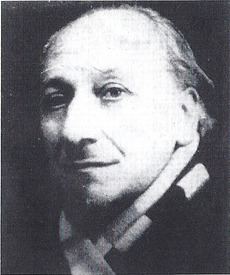Name Henri Mulet Education Conservatoire de Paris | Role Composer | |
 | ||
Similar People Eugene Gigout, Louis Vierne, Charles‑Marie Widor, Alexandre Guilmant, Diane Bish | ||
Henri mulet tu es petra
Henri Mulet (12 October 1878 - 20 September 1967) was a French composer, organ, harmonium and cello player.
Contents
- Henri mulet tu es petra
- Carillon Sortie Henri Mulet David Hicken Pianist Arranger Composer
- Biography
- Works
- Songs
- References
Carillon-Sortie - Henri Mulet - David Hicken - Pianist, Arranger, Composer
Biography
Mulet was born on 17 October 1878 in Montmartre under the shadow of Sacre-Cœur, Paris, France. He came of age assisting his father, the maitre de-chapelle of the neo-Byzantine Basilica of the Sacre-Cœur, by playing harmonium at the church. His mother taught piano and organ, and played the harmonium of the Basilica. The basilica was then under construction and the installation of the grande orgue years in the future. He was an enigmatic character, and somewhat eccentric. Because of his lack of correspondence, few friends, and solitary lifestyle, information regarding his life is limited. Although he lived for 88 years, he composed music only during about 15 of them.
Most of his published compositions were for the organ. His works for organ have been called "expressive in a post-Romantic manner.
Enrolled in the Paris Conservatoire before he was twelve years old, Henri Mulet studied cello, harmony, and organ. He won first prize for cello in Jules Delsart's class in 1893. He won second prize for organ in 1897. He studied harmony at Conservatoire de Paris under Raoul Pugno and Xavier Leroux. He studied organ with Alexandre Guilmant, Charles-Marie Widor and their assistant Louis Vierne, all of whom thought highly of the young composer and organist. Louis Vieme claimed that Mulet was "one of the most brilliant of musical personalities, a solid virtuoso, and a very fine improviser." Although Mulet held several church organ positions, his most significant position was at Saint Philippe-du-Roule, a parish of about 30,000 members. He served as an organist in several churches in Paris {choirmaster of the basilica of Sacre-Coeur, Paris and titular organist at Saint-Pierre-de-Montrouge (until 1901), St Eustache, Ste Marie des Batignolles (fr) (1910), St Roch (1912), and finally St Philippe du Roule in Paris (fr)}. He was a professor at the Ecole Niedermeyer and at the Schola Cantorum. In 1937 Mulet burnt most of his manuscripts (giving some of his orchestral manuscripts to Felix Raugel), and left Paris for Draguignan in Provence. He also owned a house overlooking Frejus, which he shared with Madame Mulet's sister and mother. In 1914 he was a member of the committee of "Societe Nationale de Musique".
Was he unhappy with the liturgical change which had begun to undermine church music? Was he bitter over the ascendant modernism of the time? Was he disillusioned by lack of recognition as composer? We can only guess. He put his ideas in "Les tendances et antireligieuses nefastes de l'orgue moderne" (published in 1922). In it, he declared himself an opponent of the modern trends (in his eyes) of reprehensible organ playing, that increasingly broke away from worship in the Catholic Church. In the attached "Etude sur le role des mutations et la composition rationelle du Plein-Jeu dans un grand orgue", he unfolded his thoughts about the technical sides of the organ, that he expressed in the restoration of the organ of the Eglise Saint-Philippe-du-Roule in the Rue du Faubourg-Saint Honore. That, was to his wishes, carried out by the organ builder Charles Mutin.
He served as organist at the cathedral in Draguignan until 1958, and afterwards he entrusted himself to the care of the nuns at the establishment there (Les Petites Soeurs des Pauvres; in English, The Little Sisters of the Poor). He was married (to Isabelle) but had no children. He spent the last 30 of his 89 years in seclusion. He died on 20 September 1967 in Draguignan. By the time of his death, he had been completely forgotten, and not one French newspaper printed his obituary. Most of his surviving music is largely unknown.
In a tribute to Mulet, Charles Tournemire wrote: "Henri Mulet, a strange and great artist, captive of a mystic ideal. A calm improviser, some times lively, some times religious. An artist worthy of the great epoch of the Masters of the Middle Ages, which, in his case, would not exclude an understanding of present-day art. A mysterious thinker".
Original source of this article is the Henri Mulet page at the Classical Composers Database (from January 2004), which was written by Ioannis Dimitroulis.
Works
Organ
The "Esquisses Byzantines", a ten-movement suite published in 1920 by Alphonse Leduc, is Mulet's most famous composition for organ. Written over a period of at least ten years, the "Byzantine Sketches" were dedicated "in memory of the Basilica of the Sacred Heart, Montmartre, 1914-1919." The tenth movement, the toccata, is thought to refer to the smaller, medieval church of Saint Pierre-de-Montmartre, an institution which had been consecrated over 700 years before the creation of the basilica. More specifically, the words "Tu es petra" refer to the biblical reference in Matthew 16:18, "Thou art Peter, and upon this rock [petra] I will build my church; and the gates of hell shall not prevail against it." The ominous tonalities of the piece, the frequent use of the minor third, the development of contrasting motifs, and the brilliant finale in the parallel major key all suggest a spiritual battle in which good does indeed triumph.
Harmonium
Orchestral
Vocal
Chamber and instrumental
Principal publishers: Leduc, Senart
Songs
Carillon-Sortie
Organ Solo: Noel From 'Esquisses Byzanthines'
Esquisses Byzantines: No 8 Noel
Esquisses Byzantines : No 10 Toccata On Tu Es Petra …
